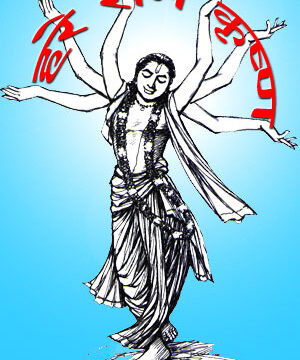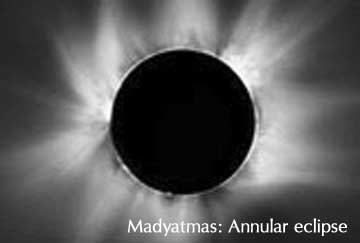 This opens a much bigger question that I have had: how should we actually define uttara-ayana. It seems that it was originally the winter solstice, where the days begin to get longer, but since it has become associated with Makara Saṅkrānti it has been riding a sidereal year, of which it is not really a sidereal calculation but a tropical calculation. If we truly are observing the Sun returning or the Sura increasing, then there is no relation to the signs, just actual ayanas (solstices).
This opens a much bigger question that I have had: how should we actually define uttara-ayana. It seems that it was originally the winter solstice, where the days begin to get longer, but since it has become associated with Makara Saṅkrānti it has been riding a sidereal year, of which it is not really a sidereal calculation but a tropical calculation. If we truly are observing the Sun returning or the Sura increasing, then there is no relation to the signs, just actual ayanas (solstices).
Namah Shivaya
Freedom T. Cole
Editor’s Reply
What we experience on earth is a miniscule of what is seen in the heavens. Tropical zodiac gives seasons on earth, the physical dimension while the sidereal zodiac gives the seasons in heaven, in the world of the devas. What we are experiencing on earth is the physical light of daytime increasing or decreasing after the equinoxes (not solstices). Solstices show when the Sun travels towards north hemisphere or south hemisphere. Either way, these four points define the kendra of the bha-chakra. Now just behind the physical Sun is a metaphysical Sun called Nārāyaṇa Who is not visible to the naked eye, but He is right there. He illumines svarga loka and all other lokas an keeps them connected.
ध्येय सदा सवित्र् मण्डल मध्यवर्ती
नारायणः सरसिजासन सन्निविष्टः।
केयूरवान् मकर कुण्डलवान् किरीटी हारी
हिरण्मय वपुः धृत शंख चक्रः॥
dhyeya sadā savitr maṇḍala madhyavartī
nārāyaṇaḥ sarasijāsana sanniviṣṭaḥ|
keyūravān makara kuṇḍalavān kirīṭī hārī
hiraṇmaya vapuḥ dhṛta śaṁkha cakraḥ||
He who is meditated upon as Lord sūryanārāyaṇa at the centre of the solar disc …
Just as planets in our solar system obey the Sun and revolve around him, the pious people on earth go to a temple and revolve around it, in what is called parikramā (circumbulation). Similarly all these solar systems revolve around Him who is Nārāyaṇa.
Just as the center of the Sun (solar system) is the Brahma nābhi, so also the center of the cosmos is the Vishnu (Nārāyaṇa) nābhi.
In such a scenario, when we talk of prayers, we must bear in mind that the mood and state of the one we are going to pray. If you have some work with a senior officer, and land up in his house when he is busy with family or in toilet, then your prayers will not be answered. You need to meet the officer in opportune time, in good mood in the office. Similarly, when the devas are asleep, of what use it is to pray? You can practice praying and that will increase bhakti, but would it not be better to approach them after they have woken up, finished bath, dressed up and go to office.
Now that is why we use the sidereal zodiac in vedic astrology, and this is just one of the reasons.
Vedic astrology is far more detailed than what is known to the public in general. For example people say that Gods go to sleep when dakṣiṇa ayana starts and blindly take the Karka saṅkrānti which is the summer solstice in heaven. But the hard question is do the gods, especially Vishnu, the one who is ordained to receive the offerings of the sacrifices, actually sleep on that very date? The answer is NO. Vishnu sleeps on śravaṇa kṛṣṇa tritīya …on that particular night and even if Karka saṅkrānti has occurred, its effects of dakṣiṇa ayana do not start immediately. It starts only after Viṣṇu sāyana.











 DBC offers online courses in jyotish (Vedic Astrology) taught directly by Sanjay Rath as per the tradition, through narrated power points and other audio tools. The courses are at different levels, from the beginners through the intermediate to the advanced and are known as SoHamsa | DBC courses, with individual classrooms and assistant teachers
DBC offers online courses in jyotish (Vedic Astrology) taught directly by Sanjay Rath as per the tradition, through narrated power points and other audio tools. The courses are at different levels, from the beginners through the intermediate to the advanced and are known as SoHamsa | DBC courses, with individual classrooms and assistant teachers
 Sagittarius Publications is the publisher and distributor the popular quaterly magazine the Jyotish Digest, as well as many thorough books on the subject of Vedic Astrology or Jyotish.
Sagittarius Publications is the publisher and distributor the popular quaterly magazine the Jyotish Digest, as well as many thorough books on the subject of Vedic Astrology or Jyotish. We have an excellent pandit Divākar ‘Deva’ Mishra, who is from the priests of Vindhyāvāsini Siddha Pīṭha to guide you through the hundreds of temples of Kāśi [Varanasi] and neighbouring regions. He can organise your pūjā, keep you safe and take care. He is supported by an English-speaking well-travelled spouse ‘Supriya Mishra’. Please contact them directly for any services, remedial pūjā and tours. They handled the 60+ member Kāśi Jyotiṣa Group 2022.
We have an excellent pandit Divākar ‘Deva’ Mishra, who is from the priests of Vindhyāvāsini Siddha Pīṭha to guide you through the hundreds of temples of Kāśi [Varanasi] and neighbouring regions. He can organise your pūjā, keep you safe and take care. He is supported by an English-speaking well-travelled spouse ‘Supriya Mishra’. Please contact them directly for any services, remedial pūjā and tours. They handled the 60+ member Kāśi Jyotiṣa Group 2022.